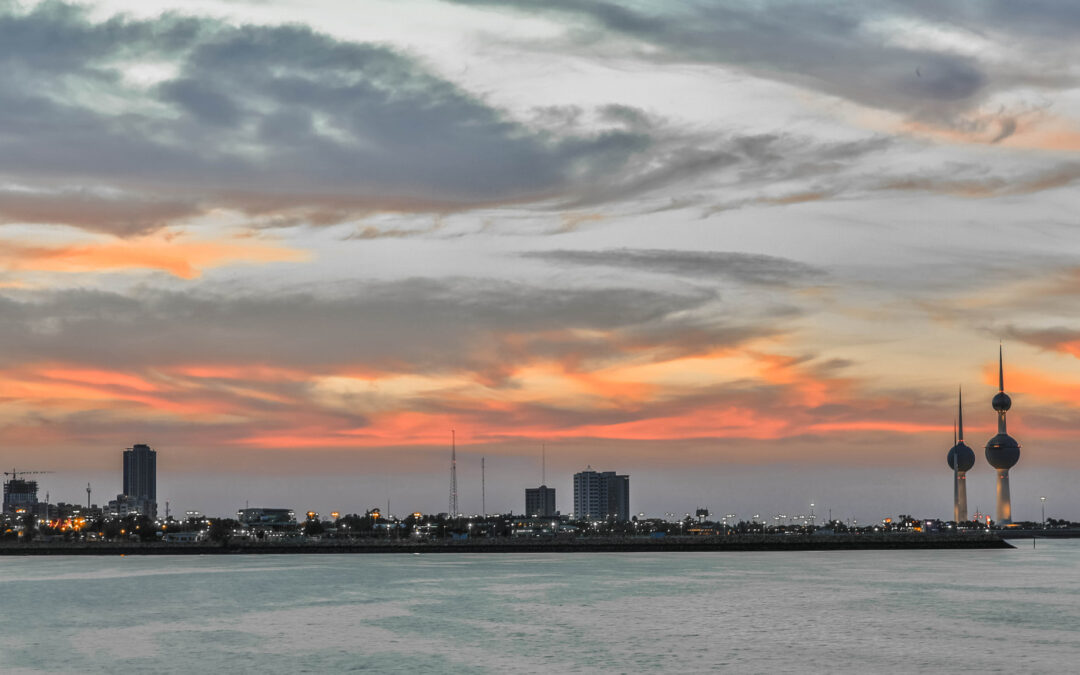The Middle East is home to many iconic buildings and structures, most notably the Burj Khalifa in Dubai, which is the tallest building in the world. The region has more than a dozen skyscrapers taller than 350 meters, each of which was constructed in the 21st century. There are also many other ornate and beautifully designed structures that, while not among the tallest in the region, stand out for different reasons.
The Kuwait Towers, a group of three thin towers of varying sizes overlooking the Persian Gulf in Kuwait City, represent traditional Arab culture. They serve as a symbol of strength and prosperity in Kuwait, which is the 10th richest country in the world per capita. The towers, constructed in 1975 and inaugurated in 1979, are also an important component of the country’s water supply and distribution and include three multi-colored spheres covered with roughly 41,000 enameled steel discs.
Below is a brief look at the history of the Kuwait Towers and their importance to the Middle East nation.
1. Part of the Kuwait Water Towers
Kuwait’s Ministry of Electricity and Water (MEW) began exploring different methods of storing water and accommodating increasing demand for the natural resource in the early 1960s. However, it wasn’t until the oil boom the following decade that it was able to commission the construction of the innovative Kuwait Towers, the sixth in a group of towers built to store water. The first five groups (31 towers in total) consist of towers ranging from 35-40 meters in height. Each is made from reinforced concrete and holds 3,000 cubic meters of water. They’re known collectively as the “mushroom towers.”
While these towers serve a practical purpose, they’re not necessarily aesthetically pleasing, nor do they dominate the Kuwait City skyline. Thus, for the sixth and final group of towers, Sheikh Jaber Al-Ahmed, Amir of Kuwait, wanted a more ambitious and attractive design.
The three structures that comprise the Kuwait Towers are considerably taller than the mushroom towers. They feature three multicolored spheres, two of which are on the 187-meter-tall main tower. The bottom half of the lower sphere features a 4,500-cubic-meter water tank. There’s another 4,500-cubic-meter water tank in the second tower, which is 147 meters tall. The third tower, a 100-meter design in the shape of an elegant white needle, has a floodlight system that illuminates the other two towers during the at night.
The towers were constructed from concrete, although the tips of each building are covered with stainless steel that has been welded to the steel reinforcement to function as lightning conductors. The Kuwait Water Towers received the Aga Khan Award for Architecture in 1980.
2. Designed by Swedish Engineering Company
Kuwait commissioned Swedish engineering firm VBB, now known as Sweco, to construct the Kuwait Water Towers. Danish architect Malene Bjørn led design efforts, while Serbian construction company Energoprojekt built the three ornate Kuwait Towers. The three spheres are made of steel discs in eight shades of green, blue, and gray, like the tiled domes of ancient mosques.
The Kuwait Towers represent a “merger of Arab culture and Western technology, a combination of forces that might well be regarded as a prerequisite of achievement for any country in the rapidly changing Near East,” noted Swedish writer Ulf Hard, who compared the iconic towers in cultural importance significance to the Eiffel Tower and Statue of Liberty.
3. Should Inside the Towers
The Kuwait Towers don’t just serve the practical purpose of storing water. The upper half of the sphere on the tallest tower features an open-plan restaurant known as the Ofok and a slow rotating observation platform on the 121st floor. There are various images of Kuwait City, including those depicting the damage done to the Kuwait Towers during the Iraqi occupation, along the walls in the stairwell. Guests must pay an entry fee unless planning to eat at the restaurant.
The main tower was also the host site of the TEDxKuwaitCity conferences in 2018 and 2019. The event featured speakers such as filmmaker Abdullah Al-Mukhyal, author and historian Abdulaziz Alateeqi, and artist and architectural engineer Faried Omarah.
4. Damaged in 1990 and Closed from 2012 to 2016
The three Kuwait Towers were almost destroyed during the Iraqi occupation of the country, which lasted from August 2, 1990, to February 25, 1991. Under the direction of Saddam Hussein, Iraqi soldiers sought to remove all symbols of an independent Kuwait. This caused extensive damage to the exterior of the towers via gunfire and shrapnel.
They also destroyed interior facilities and wrecked all electrical utilities. It cost about KD 2 million to restore the Kuwait Towers to their original condition. The towers reopened on December 26, 1992. This marked a proud and symbolic moment for all citizens of Kuwait.
That wasn’t the only time the towers were closed, however. They were also shut down for maintenance from March 2012 to March 2016, during which time contractors renovated and upgraded the facilities. There was a fireworks festival to celebrate its re-opening on March 5.

